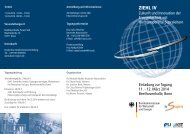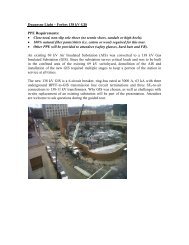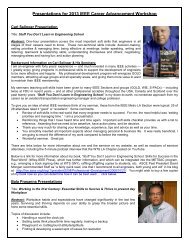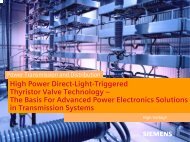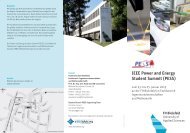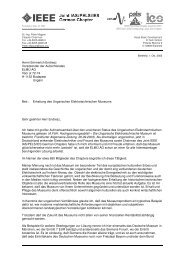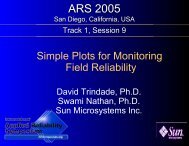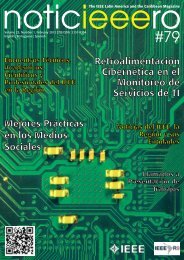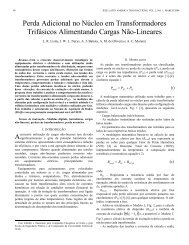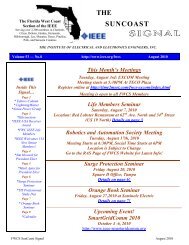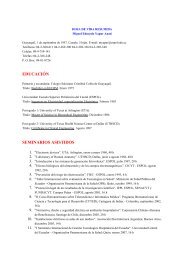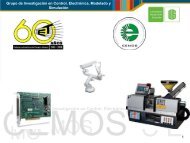continued from page 1 - IEEE Entity Web Hosting IEEE Entity Web ...
continued from page 1 - IEEE Entity Web Hosting IEEE Entity Web ...
continued from page 1 - IEEE Entity Web Hosting IEEE Entity Web ...
Create successful ePaper yourself
Turn your PDF publications into a flip-book with our unique Google optimized e-Paper software.
Consumer Electronics<br />
Society<br />
Newsletter<br />
From the President<br />
William Lumpkins<br />
Wi2Wi Inc.<br />
xillia@ieee.org<br />
My last year and my last article for the <strong>IEEE</strong> Consumer<br />
Electronics Society Newsletter as President is<br />
both a joyous and slightly sad reminder of growth<br />
in all of our lives. I have truly enjoyed helping out<br />
with the society, I have learned a lot through many of the senior volunteers<br />
in our Society and <strong>from</strong> the numerous suggestions I have received<br />
these past two years. I want to give special thanks to Charlotte Kobert,<br />
our Executive Assistant-Conference Organizer-Committee Support person.<br />
She has been instrumental in helping keep our Society on track for<br />
many years and I am sure she will continue to do so with the next President<br />
and our new recently voted in AdCom members.<br />
I would like to welcome the recently elected Administrative Committee<br />
members for 2009, Dr. Robin Sarah Bradbeer, Dr. Tomohiro Hase,<br />
Wayne C. Luplow, Brian Markwalter and myself. Our terms will expire<br />
on 31 December 2011. I want to thank Stefan Mozar who has valiantly<br />
enabled the CE Society to try Electronic Balloting this year, though a bit<br />
costly, I think it was worth the increase in participation. We will try to<br />
use electronics balloting next year and hopefully we will be able to<br />
reduce the cost as well. As always, we need volunteers, please consider<br />
running for next year’s open AdCom slots as well as volunteering to<br />
our many open committee positions. Please contact Stefan Mozar at<br />
s.mozar@ieee.org.<br />
I am pleased to announce two new CE Chapters that have joined<br />
our fold, the recently approved Beijing, main point of contact (Dong<br />
Liu at dliu@biigroup.com), and Malaysia, main point of contact Abd<br />
Ramli at (arr@eng.upm.edu.my) chapters were formed and we wish<br />
them well in increasing their membership and activities in their respective<br />
areas. We hope to hear more <strong>from</strong> them in the near future. If you<br />
are interested in starting a chapter in your area, please do not hesitate<br />
to contact Stefan Mozar for further info.<br />
Recently I went to see Eagle Eye, an exciting adventure with a twist<br />
relating to Artificial Intelligence (AI). Of course with most things in<br />
Hollywood the level of reality is not proportional to the level of technology<br />
involved in the story line but hey, it’s a movie! At least people<br />
are more aware of the concept of AI. Along with the recent <strong>IEEE</strong> Spec-<br />
Fall 2008 ■ Number 4<br />
http://ewh.ieee.org/soc/ces/<br />
Table of Contents<br />
From the President .................1<br />
AdCom Members .................2<br />
CES Invades 2008 <strong>IEEE</strong> Sections Congress 3<br />
ICCE 09 Schedule-At-A-Glance ......4<br />
Digital Storage in Consumer Electronics . 6<br />
TI-MSP430 Demo Kits for CE Society<br />
Student Chapters. .................8<br />
Keynote Speakers at ICCE ...........8<br />
Short Circuits.........................9<br />
Letters to the Editor ................10<br />
SMPTE. ..........................12<br />
Call for Papers ....................12<br />
CEA Projects .......................13<br />
Sampling the Consumer Electronics<br />
Tranactions Over 100 Papers to Choose<br />
From...............................14<br />
CES Turns the Spotlight on Students ....15<br />
ICCE 2009 ..........................16<br />
click<br />
go to www.ieee.org, To join, as a member. you wants Society<br />
<strong>continued</strong> on <strong>page</strong> 3<br />
Electronics Consumer<br />
issn 1082-748XThe <strong>IEEE</strong><br />
on “membership.” Click, “Join a Society.” You will be able to add CE Society membership if you are<br />
already an <strong>IEEE</strong> member, or you will be able to join as an affiliate if you are not an <strong>IEEE</strong> member.
2008 CHAPTER CHAIRS<br />
BEIJING<br />
DONG LIU<br />
dliu@biigroup.com<br />
BENELUX<br />
KEES A IMMINK<br />
immink@turing-machines.com<br />
CHICAGO-JT. CHAPTER<br />
AryE NEhOrAI<br />
nehorai@ece.uic.edu<br />
DALLAS<br />
SUE hUI<br />
shui@ti.com, suehui2000@yahoo.com<br />
HONG KONG<br />
KF TSANG<br />
ee330015@cityu.edu.hk<br />
JAPAN<br />
TAIIChIrO KUrITA<br />
kurita.y-hm@nkh.or.jp<br />
MALAYSIA<br />
ABD rAMLI<br />
arr@eng.upm.edu.my<br />
OTTAWA-JT. CHAPTER<br />
IAN GLENN<br />
ian.glenn@ieee.org<br />
PHILADELPHIA-CHAPTER<br />
GAIL rOSEN<br />
gailr@mail.ece.drexel.edu<br />
PORTUGAL CE/CAS/BT JT. CHAPTER<br />
ANTONIO NAvArrO<br />
navarro@av.it.pt<br />
PRINCETON-CENTRAL JERSEY-JT. CHAPTER<br />
PADMANABhA rAjAGOPALAN<br />
prajagopalan@gmail.com<br />
RUSSIA<br />
DMITry TKAChENKO<br />
dtkach@mail.wplus.net<br />
SANTA CLARA VALLEY<br />
GAry SASAKI<br />
gary.sasaki@digdia.com<br />
SINGAPORE<br />
EE PING ONG<br />
epong@i2r.a-star.edu.sg<br />
TAIPEI<br />
TIhAO ChIANG<br />
tchiang@mail.nctu.edu.tw<br />
UK&RI<br />
SCOTT LINFOOT<br />
slinfoot@dmu.ac.uk<br />
STUDENT CHAPTERS<br />
St. Petersburg Chapter<br />
UC Santa Cruz Chapter<br />
George Mason University Chapter<br />
Newsletter Deadlines<br />
December 15 - Winter, 2008<br />
March 15 - Spring, 2009<br />
june 15 - Summer, 2009<br />
CE SOCIETY NEWSLETTER<br />
EDITORIAL BOARD<br />
Editor<br />
jim Farmer, jofarmer@mindspring.com<br />
Associate Editors<br />
Stefan Mozar, s.mozar@ieee.org<br />
Bernard Fong, bfong@ieee.org<br />
jianping Zhou, jianping.zhou@gmail.com<br />
Tom Caughlin, tom@tomcoughlin.com<br />
Stu Lipoff, stu@lipoff.org<br />
George hanover, georgehanover@att.net<br />
Samad Ahmadi, sahmadi@dmu.ac.uk<br />
<strong>IEEE</strong> CONSUMER ELECTRONICS SOCIETY<br />
2008 ADMINISTRATIVE COMMITTEE<br />
Term Expires 2008<br />
William Lumpkins<br />
President<br />
Wi2Wi Inc.<br />
2107N. 1st Street Ste 540<br />
San jose. CA 95131<br />
xillia@yahoo.com<br />
james O. Farmer<br />
Newsletter Editor<br />
Wave7 Optics Inc<br />
1075 Windward ridge<br />
Parkway, Suite 170<br />
Alpharetta, GA 30005<br />
jofarmer@mindspring.com<br />
Stefan Mozar<br />
2nd vice President-International<br />
Affairs/Chapter relations<br />
& Nominations Chair<br />
44 Meurants Lane<br />
Glenwood NSW 2768 Australia<br />
s.mozar@ieee.org<br />
r. Simon Sherratt<br />
2009 ICCE Chairman,<br />
vP of Conferences<br />
University of reading<br />
School of Systems Engineering<br />
reading rG6 6Ay<br />
United Kingdom<br />
R.S.Sherratt@Reading.ac.uk<br />
Term Expires 2009<br />
Tzy-hong Steve Chao<br />
Student Membership<br />
Subcommittee<br />
Industrial Technology<br />
Investment Corporation<br />
National Chiao-Tung University<br />
No 16, Alley 3, Lane 168,<br />
Edison road<br />
Bao-Shan Township<br />
hsinchu County<br />
308 Taiwan, r.O.C.<br />
stevechao@giga.net.tw<br />
Tom Coughlin<br />
Coughlin Associates<br />
1665 Willowmont Ave<br />
San jose CA 95124-3234<br />
tom@tomcoughlin.com<br />
George hanover<br />
Membership & Student<br />
relations<br />
Consultant to the Consumer<br />
Electronics Industry<br />
4139 Evergreen Drive<br />
Fairfax, vA 22032-1018<br />
georgehanover@att.net<br />
Uwe E. Kraus<br />
University of Wuppertal<br />
rainer-Gruenter-Str. 21<br />
Building FE 42119<br />
Wuppertal, Germany<br />
krausue@uni-wuppertal.de<br />
Ulrich reimers<br />
First vice President<br />
& Fellow Evaluator<br />
Institute for Communications<br />
Technology<br />
Braunschweig Technical<br />
University<br />
Schleinitzstrasse 22<br />
38092 Braunschweig<br />
Germany<br />
u.reimers@tu-bs.de<br />
Term Expires 2010<br />
Stephen D. Dukes<br />
Imaginary Universes, LLC.<br />
370 N. East Camano Drive<br />
Suite 5, #451<br />
Camano Island, WA 98282<br />
stephendukes@verizon.net<br />
ralph justus<br />
EIA Standards & Technology<br />
Electronic Components,<br />
Assemblies<br />
and Materials Association<br />
2500 Wilson Boulevard<br />
Arlington, vA 22201-3834<br />
rjustus@ecaus.org<br />
Scott Linfoot<br />
De Montfort University<br />
School of Engineering and<br />
Technology<br />
Queen’s Building<br />
The Gateway<br />
Leicester<br />
UK<br />
LE1 9Bh<br />
sllinfoot@dmu.ac.uk<br />
Leander h. hoke, jr.<br />
Treasurer<br />
613 E. Fox Den Drive<br />
Knoxville. TN. 37934<br />
L.Hoke@ieee.org<br />
Larry Zhang<br />
Awards Chairman<br />
Texas Instruments Inc.<br />
12500 TI BLvD<br />
Dallas, TX 75243<br />
l-zhang1@ti.com<br />
Ex-Officio Members<br />
hans Baumgartner<br />
hans Baumgartner<br />
Past President<br />
Sarnoff Corporation<br />
933 Golden Gate Drive<br />
San Diego, CA 92116<br />
h.baumgartner@ieee.org<br />
Michael A. Isnardi<br />
representative to ATSC<br />
Sarnoff Corporation<br />
CN 5300<br />
Princeton, Nj 08534-530<br />
misnardi@sarnoff.com<br />
Stuart Lipoff<br />
Technical Activities and<br />
Standards<br />
IP Action Partners<br />
192 Kirkstall road<br />
Newton, MA. 02460<br />
s.lipoff@ieee.org<br />
AdCom Minutes:<br />
http://www.ewh.ieee.org/soc/ces/AdComMeetings.htm<br />
Wayne C. Luplow<br />
vice President of Publications &<br />
Transactions Editor<br />
Zenith Electronics Corporation<br />
2000 Millbrook Drive<br />
Lincolnshire, IL. 60069<br />
w.luplow@ieee.org<br />
Brian Markwalter<br />
CEA Liaison<br />
Consumer Electronics<br />
Association<br />
2500 Wilson Boulevard<br />
Arlington, vA. 22201-3834<br />
bmarkwalter@CE.org<br />
Teodor Buburuzan<br />
<strong>Web</strong> Master<br />
Institute for Communications<br />
Technology<br />
Technical University of<br />
Braunschweig<br />
Schleinitzstraße 22 (room 217)<br />
D - 38106 Braunschweig<br />
Germany<br />
buburuzan@ifn.ing.tu-bs.de<br />
Daniel Eisenman<br />
Student Membership vice-Chair<br />
Pragmatics Technology<br />
1275 Lincoln Ave. Suite #7<br />
San jose, CA. 95125<br />
eisenman@gmail.com<br />
Christian hentschel<br />
Distinguished Lecturer<br />
Coordinator<br />
University of Technology<br />
Cottbus<br />
Konrad-Wachsmann-Allee 1<br />
03046 Cottbus Germany<br />
christian.hentschel@tu-cottbus.<br />
de<br />
reinhard Moeller<br />
Transactions on haptics<br />
Manager<br />
University of Wuppertal<br />
Faculty E<br />
rainer-Gruenter-Str. 21, Bld. FC<br />
D - 42119<br />
Wuppertal Germany<br />
r.moeller@computer.org<br />
Charlotte Kobert<br />
AdCom Executive Administrator<br />
4115 Clendenning road<br />
Gibsonia, PA 15044<br />
ckobert@zbzoom.net<br />
<strong>IEEE</strong> Consumer Electronics Society Newsletter (ISSN 1082-748X) is published quarterly by the <strong>IEEE</strong> Consumer Electronics Society of The Institute of Electrical and<br />
Electronics Engineers, Inc. Headquarters: 3 Park Avenue, 17th Floor, New York, NY 10016-5997. An assessment of $1.00 per member per year (included in Society fee)<br />
for each member of the <strong>IEEE</strong> Consumer Electronics Society is made. This newsletter is printed in the U.S.A. Application to mail at Periodicals postage rates is<br />
pending at New York, NY and at additional mailing offices. Postmaster: Send address changes to <strong>IEEE</strong> Consumer Electronics Society Newsletter, <strong>IEEE</strong>, 445 Hoes<br />
Lane, Piscataway, NJ 08855-1331.<br />
Copyright 2008 <strong>IEEE</strong>. Permission to copy without fee all or part of any material without a copyright notice is granted provided that the copies are not made or<br />
distributed for direct commercial advantage and the title of publication and its date appear on each copy. To copy material with a copyright notice requires<br />
special permission. Please direct all inquiries or requests to <strong>IEEE</strong> Intellectual Property Rights Manager, <strong>IEEE</strong> Service Center, 445 Hoes Lane, Piscataway, NJ 08855. Tel:<br />
+1 732 562 3966, FAX: +1 732 981 8062, EMAIL: copyrights@ieee.org
From the President <strong>continued</strong> <strong>from</strong> <strong>page</strong> 1<br />
trum issue related to the Singularity<br />
Event (The point in time in which AI’s<br />
are accepted or recognized as sentient<br />
beings in our universe). I am again<br />
honored to know that the <strong>IEEE</strong> Consumer<br />
Electronics Society is in the<br />
forefront with its new Journal of AI in<br />
Games as well as Autonomous Mental<br />
Development.<br />
ICCE 2009 www.icce.org Jan 10th<br />
~ 14th is around the corner, I know<br />
that it will again be an exciting conference<br />
filled with good food, exciting<br />
lectures and the meeting of old<br />
friends with new. I am looking forward<br />
to Stu Lipoff’s newest activity<br />
for the conference, it is supposed to<br />
be a secret but I hear it involves lots<br />
of interactive games. I can’t wait. On<br />
that note, I hear good things are in the<br />
works for the Dr. Hase’s ISCE 2009<br />
www.isce2009.ryukoku.ac.jp conference<br />
May 25th ~ 28th in Kyoto, Japan.<br />
I can’t wait to try Natto Ice Cream<br />
and enjoy the cultural beauty of the<br />
Classical country side of Ancient<br />
Kyoto Japan.<br />
In closing, I want to say thanks<br />
again for being a member of the<br />
<strong>IEEE</strong> Consumer Electronics Society<br />
by helping us to bring the CE society<br />
further into the technical spotlight<br />
with so many new journals<br />
and avenues of interest. I look for-<br />
ward to working with you all at our<br />
various conferences or possibility<br />
on one of our new standards that<br />
we are developing.<br />
Thanks Again,<br />
William J. Lumpkins<br />
<strong>IEEE</strong> Consumer Electronics Society<br />
President 2006 ~ 2008<br />
(And thanks to you, Will, for the exceptional<br />
leadership you have provided to<br />
us. It truly has been a pleasure to work<br />
with you – ed.)<br />
Consumer Electronics Society Invades 2008 <strong>IEEE</strong> Sections Congress<br />
By Scott Linfoot, Society Secretary<br />
September 18-22nd 2008, Quebec, Canada<br />
was the time and place for the 2008<br />
<strong>IEEE</strong> Sections Congress. Arranged by the<br />
Quebec Section of the <strong>IEEE</strong> (Region 7), it<br />
was a melting pot of <strong>IEEE</strong> members <strong>from</strong><br />
every corner of the Earth with over 1200<br />
delegates attending.<br />
If this was a Section/Region-based<br />
congress, why was the Consumer Electronics<br />
Society represented? Well, three<br />
members of the AdCom – Scott Linfoot,<br />
Tom Coughlin and Larry Zhang were<br />
all invited as representatives of their<br />
respective sections (UK and Republic of<br />
Ireland, Santa Clara, CA and Dallas, TX<br />
respectivly) so it was an excellent opportunity<br />
to show the rest of the world that<br />
there was a Consumer Electronics Society<br />
and to demonstrate the sorts of activities<br />
that we do.<br />
As one of only three societies represented<br />
at this congress, it was an excellent<br />
opportunity to talk to other volunteers of<br />
the <strong>IEEE</strong> and to describe the goals of the<br />
CE Society.<br />
Although targeted at regional activities,<br />
there were a number of breakout sessions<br />
that were applicable to the Society.<br />
Some of the sessions included how to<br />
develop standards, the benefits to mem-<br />
bers and the roles of volunteers and how<br />
to attract them.<br />
The awards ceremony was excellent.<br />
This year’s <strong>IEEE</strong> Medal was given out to<br />
Gordon Moore for his work on semiconductor<br />
theory. This was an interesting<br />
event not totally unlike the Emmys (except<br />
without all the celebrities – although, of<br />
course, many of the people at this event<br />
are celebrities in their chosen fields)<br />
I would like, however, to share something<br />
with you all if I may. One shocking<br />
revelation that came <strong>from</strong> our presence at<br />
this congress is the few people who had<br />
realised that there was a Consumer Electronics<br />
Society. Out of the 500 or so people<br />
who visited the stand (a tally was taken to<br />
measure the impact of our presence), there<br />
were surprisingly few people who knew<br />
that the CE Society even existed (with only<br />
a handful actually being members). 100<br />
people had some idea what Consumer<br />
Electronics is all about. The remaining 349<br />
or so were totally oblivious to the existence<br />
of our highly important Society, although<br />
many of them were glad to see that there<br />
was a Society dedicated to the needs of<br />
industry instead of the many other (very<br />
respectable) societies who tend to verge on<br />
the edge of academia.<br />
Most visitors to the stand started with<br />
“so, what is the Consumer Electronics<br />
Society all about? I didn’t realise that<br />
there was one.” It was, of course, the role<br />
of Scott, Tom and Larry to educate them,<br />
and they spent 3 days convincing people<br />
of the importance of the CE Society and<br />
how it sits on the scheme of things. Many<br />
of the delegates went away with at least<br />
an appreciation of what the society is trying<br />
to achieve.<br />
All in all, the event was very positive<br />
and even if we didn’t recruit a single<br />
person (which I find it hard to believe<br />
given the number of industrialists that<br />
were present), we have taken steps to<br />
increase public awareness of the Society<br />
and its goals.<br />
On a final note, one of the things<br />
that I picked up <strong>from</strong> the congress is<br />
that there is an incentive <strong>from</strong> the <strong>IEEE</strong><br />
in that if you recommend a colleague<br />
to become a member of the <strong>IEEE</strong>, you<br />
will receive a reduction of $15 <strong>from</strong><br />
your next year’s dues (up to a maximum<br />
of $90). While you are at it, why<br />
not suggest that they join the CE Society?<br />
At $15 per year, it is certainly one<br />
of the cheaper societies yet with so<br />
many benefits.<br />
<strong>IEEE</strong> Consumer Electronics Society Newsletter/Fall 2008 3
“Here are the exciting topics you’ll hear about at the ICCE in January. To register, go to http://www.icce.org”<br />
4 <strong>IEEE</strong> Consumer Electronics Society Newsletter/Fall 2008
Many types of memory<br />
Digital Storage in Consumer Electronics<br />
Tom Coughlin<br />
published by Newnes Press (a division of Elsevier, March 2008)<br />
This is an except <strong>from</strong> a new book by this name written by our own Tom Coughlin.<br />
The author has kindly condensed the material and secured permission for us to publish it.<br />
Memory is a key element in the design<br />
of modern digital electronics. Memory<br />
allows the retention of information<br />
that can be used by the electronic system.<br />
Memory is information. This<br />
information may be computer files but<br />
it can also be digital photographs,<br />
home videos, movies, music and other<br />
personal and commercial content. The<br />
content is what makes these devices<br />
useful and digital storage is where the<br />
content resides.<br />
Electronic memory may be temporary<br />
as is the case for volatile<br />
memory, where the information it<br />
contains disappears when the power<br />
is turned off, or it may be long term<br />
memory, or non-volatile memory.<br />
Memory may be fast or slow, low<br />
power consumption or high power<br />
consumption, it may be inexpensive<br />
per byte or expensive. It may be part<br />
of the microprocessor electronics, a<br />
peripheral chip, an internal mass<br />
storage unit or an external digital<br />
storage device…<br />
Growth in digital content<br />
drives storage growth<br />
Demand for digital storage is driven<br />
by the growth in personal family<br />
content, by the growing number of<br />
entertainment devices in and around<br />
the home that require digital storage,<br />
by the increasing resolution of personal<br />
and commercial entertainment<br />
content, and by the growth in the<br />
number of channels that people can<br />
use to access all types of content.<br />
More consumers have digital still<br />
and video cameras, either as standalone<br />
devices or in convergence<br />
devices such as cell phones. Content<br />
creation devices such as digital still<br />
and video cameras are becoming a<br />
common standard application that<br />
can be built into consumer devices.<br />
In addition to being ubiquitous, camera<br />
resolutions make digital storage<br />
demands higher with time.<br />
Families today have many ways<br />
to enjoy content. No longer must<br />
they be tied to a schedule for programs<br />
on the television. Content can<br />
be recorded <strong>from</strong> broadcast, cable or<br />
satellite broadcasts on a digital video<br />
recorder to play back later. Audio or<br />
video content can be downloaded<br />
<strong>from</strong> the internet and listened to on a<br />
variety of static and mobile devices<br />
such as MP3 players and personal<br />
media players (PMPs). This content<br />
is likely to be stored on personal<br />
computers and possibly backed up<br />
to external storage devices.<br />
In an increasing number of homes<br />
content may be stored in a network<br />
storage device and made available<br />
through a wired or wireless network<br />
to various static and mobile devices<br />
throughout the home. Even automobiles<br />
are increasingly containing digital<br />
content for entertainment and<br />
navigation purposes. In the future all<br />
of these mobile and static devices may<br />
be part of far more comprehensive<br />
home storage network architecture.<br />
Content sharing and access is<br />
growing enormously. Content can<br />
be downloaded <strong>from</strong> the internet<br />
and watched now or later, it can be<br />
brought down to a cell phone<br />
through the mobile phone network<br />
and is can be shared with everyone<br />
via the many growing social networking<br />
web sites.<br />
In all cases the resolution of the content<br />
that people want is increasing.<br />
Content is compressed for two basic<br />
reasons. First, it is compressed to get<br />
through slow network connections and<br />
to speed up downloading. Second, it is<br />
compressed to conserve digital storage<br />
space required. Compression can be<br />
lossy or loss-less. Lossy compressed<br />
content cannot be reconstructed to its<br />
original resolution whereas loss-less<br />
content can be reconstructed using<br />
decompression technology.<br />
With increasing internet connection<br />
speeds and the low cost of digital<br />
storage capacity today we are<br />
likely to see changes in the resolution<br />
of content people may want.<br />
For instance MP3 files are a lossy<br />
compressed format where up to 90%<br />
of the original content file is lost during<br />
compression. The compression<br />
is done with a very fine human hearing<br />
compression model so in a noisy<br />
environment and with less than optimal<br />
acoustic equipment you probably<br />
can’t tell that there is content<br />
missing. With faster internet speeds<br />
and low cost storage there is beginning<br />
to be a pronounced shift <strong>from</strong><br />
MP3 to less compressed or even lossless<br />
compressed music formats…<br />
(Table 1.1) can give us an estimate<br />
of the acceptable size of storage for<br />
various applications at various resolutions,<br />
following are some examples:<br />
• A 4-megapixel photo viewer with<br />
20,000 images needs 20 GB<br />
• A 8-megapixel photo viewer with<br />
20,000 images needs 40 GB<br />
• A 10,000 song MP3 player needs 40 GB<br />
• A 10,000 song high definition<br />
(HiD) player (like a compressed<br />
DVD audio) needs 1.5 TB<br />
• A 100 movie player at VGA resolution<br />
needs 70 GB<br />
• A 100 movie player at DVD resolution<br />
needs >400 GB<br />
• A combination 20k 4-Mpixel photo,<br />
10k MP3 song, 100 VGA movie<br />
player needs 130 GB<br />
• A combination 20k 8-Mpixel photo,<br />
10k HiD song, 100 DVD movie<br />
player needs 1.75 TB<br />
<strong>IEEE</strong> Consumer Electronics Society Newsletter/Fall 2008 5
Consumer product price<br />
and demand<br />
There are significant differences<br />
between the retail and service markets<br />
for consumer electronic devices. The<br />
retail market is primarily a push market<br />
where retailers advertise products<br />
and offer various marketing approaches<br />
and discounts to persuade potential<br />
customers to make purchases. By contrast,<br />
the service market, typified by<br />
call phone and cable companies, offers<br />
the consumer electronics hardware for<br />
free, at a discount, or on a low-cost<br />
lease basis in order to increase the services<br />
purchased as an on-going subscription<br />
by the customer.<br />
The retail market for consumer electronic<br />
products is very price sensitive<br />
and digital storage devices are often<br />
one of the more expensive components<br />
used in these products. Consumer<br />
products are often purchased with discretionary<br />
funds so price is a very<br />
important factor in a purchase decision.<br />
Figure 1 represents the willingness of<br />
customers to purchase a consumer<br />
device as a function of product price.<br />
Note that SSPL means single spouse<br />
permission limit (what an adult could<br />
generally purchase without getting into<br />
trouble) while NPZ means no permission<br />
zone (what an individual could probably<br />
buy with no negative repercussions) .<br />
Clearly the sales volume increases significantly<br />
as the sales price declines. The SSPL<br />
point is estimated to be about between<br />
$100 and $200 retail while the NPZ is less<br />
than $99. Above $200 the purchase is likely<br />
to require at least some family discussion<br />
before a purchase is made in order to<br />
avoid financial problems or at least some<br />
level of heated discussion.<br />
New opportunities for<br />
electronic integration<br />
Technologies used in consumer electronic<br />
products come <strong>from</strong> many<br />
sources and have varied histories.<br />
GPS positioning technologies were<br />
originally developed by the military<br />
and only in the last 15 years have<br />
come into use by consumers. Today<br />
GPS-based positioning capability has<br />
become one of those standard functions<br />
that are being built into con-<br />
Figure 1 Sales volume as a Function of Product Price (source: Cornice)<br />
sumer electronic products.<br />
Often consumer electronics product<br />
technologies are expensive to<br />
manufacture at first and then go<br />
down in price as product yields<br />
increase and unit volumes go up.<br />
Optical disc media product introductions<br />
often follow this trend. Every<br />
new optical disk format <strong>from</strong> CD to<br />
blue laser discs (HD DVD and Blu<br />
Ray) started out costing over $1,000<br />
per player and decreased to less than<br />
$200 within about 5 years <strong>from</strong> initial<br />
commercial introduction. Consumer<br />
markets have market niches, one of<br />
which is high end consumers that, for<br />
example, put elaborate home theaters<br />
in their homes. These early adoption<br />
consumers drive the initial market for<br />
products and often but not always<br />
determine whether a product will be<br />
successful in a broader market.<br />
There are many sources of consumer<br />
product ideas, but whatever the<br />
source they often start out expensive<br />
initially and then decrease in price<br />
with time. With new technological<br />
development, such as less expensive<br />
memory they may also develop more<br />
capabilities with time for the same or<br />
lower prices. Digital storage is one of<br />
the key technologies for many of these<br />
applications and as indicated, for<br />
many products it is one of the largest<br />
contributors to the cost of the device.<br />
The cost reduction of consumer products<br />
is often dependent upon lowering<br />
the cost of storage.<br />
Another important factor in the<br />
reduction of consumer electronic<br />
product cost is to integrate more of<br />
the application functions into fewer<br />
and fewer electronic components.<br />
This is enabled by smaller and smaller<br />
semiconductor line-widths. With<br />
smaller area required to make an<br />
electronic component more functions<br />
can be integrated on a given chip.<br />
As discussed later in this book, electronic<br />
integration of standard consumer<br />
applications and standard<br />
consumer oriented commands built<br />
into storage products may allow<br />
achievement of even greater levels of<br />
product integration.<br />
Ultimately digital storage and the<br />
electronics could essentially become<br />
one produced manufacturing unit.<br />
This integration of storage and applications,<br />
perhaps enabled by firmware<br />
(software programmable<br />
functions) could open a whole new<br />
era of manufacturing cost reductions.<br />
Tighter integration of the<br />
overall system architecture with<br />
shorter electronic lead lengths would<br />
allow faster, more reliable products.<br />
Rules for design of digital<br />
storage in consumer<br />
electronics<br />
Based upon observations of what<br />
works and what doesn’t work in the<br />
design of digital storage in consumer<br />
electronic products I would like to<br />
propose some rules for digital storage<br />
design. These rules, if followed,<br />
should help make such products<br />
more successful in the market place.<br />
These rules are:<br />
• Use the most cost-effective storage<br />
component(s) that provide enough<br />
capacity for the application.<br />
• Never design a product where you<br />
6 <strong>IEEE</strong> Consumer Electronics Society Newsletter/Fall 2008
intentionally limit the available<br />
storage capacity to the customer—<br />
always allow a means of storage<br />
capacity expansion.<br />
• If appropriate, incorporate the<br />
advantages of multiple types of digital<br />
memory to achieve some of their<br />
individual advantages. Often a<br />
hybrid product using multiple types<br />
of storage is better for an application<br />
than a single storage device.<br />
• Use electronics and firmware to<br />
protect the customer’s content and<br />
battery life.<br />
• Make it easy to back up and copy<br />
data (storage is cheap, time is not!).<br />
• Give consumers a way to protect<br />
their personal content and privacy<br />
(encryption of data on the storage<br />
devices could help with this).<br />
• Make storage management and<br />
organization automatic—for<br />
instance protect data and prevent<br />
replication of corrupt data.<br />
• Design the components including<br />
storage to provide lowest total<br />
product cost (storage integration<br />
concepts could help here)…<br />
Classification of devices<br />
using storage in the home<br />
We classify five types of digital storage<br />
devices or devices heavily<br />
dependent upon digital storage used<br />
in and around the home, including<br />
mobile devices and automotive<br />
devices. These are:<br />
1. Active devices allowing user interaction<br />
with other devices to<br />
exchange content files. These<br />
include computers, PDAs and<br />
smart phones.<br />
2. Drone players that retain content<br />
for play out after it has been<br />
downloaded <strong>from</strong> another local<br />
source, usually an active device.<br />
3. Direct attached external storage<br />
devices used to expand local storage<br />
of another device or for backup<br />
of content on the other device..<br />
These external direct attached storage<br />
devices may use USB, Firewire<br />
(<strong>IEEE</strong> 1394), e-SATA or other less<br />
common external interfaces.<br />
4. Network attached external storage<br />
devices used to provide a central<br />
content sharing device or centralized<br />
backup of content on other<br />
devices.<br />
5. Static or mobile personal content<br />
creation devices such as a digital<br />
still or video camera or perhaps in<br />
the future a “life-log” device. Such<br />
personal content may then be<br />
saved on an active device, a direct<br />
attached storage device or a networked<br />
storage device…<br />
Consumer electronics<br />
storage hierarchies<br />
We will examine the uses of various<br />
digital memories in electronic devices<br />
to get an understanding of what<br />
sort of trade-offs designers have to<br />
make in their electronic designs.<br />
Then we will broaden our analysis to<br />
look at storage hierarchies for static<br />
and mobile consumer applications.<br />
We shall use these hierarchies to lay<br />
down some general guidelines on<br />
what storage to use for different<br />
applications, including how different<br />
storage devices can be used together<br />
to create hybrid storage devices that<br />
combine good features of both types<br />
of storage…<br />
Multiple storage and<br />
hybrid storage devices<br />
While single storage devices consumer<br />
electronic products may give<br />
basic functionality they may not provide<br />
all the features that customers<br />
want. This often leads consumer<br />
product designers to build into the<br />
device multiple storage devices or<br />
external connections to allow for<br />
digital storage expansion…<br />
Chapter summary<br />
• Large digital storage capacities at<br />
an affordable price are key drivers<br />
of new consumer electronic products.<br />
With larger storage capacities<br />
consumers can store and access<br />
ever larger collections of higher<br />
resolution content. The high end<br />
audio/video player of the future<br />
may easily require several hundred<br />
GB of storage capacity.<br />
• The consumer electronics market is<br />
a very price sensitive market. Prod-<br />
ucts with prices greater than about<br />
$200 generally sell lower volume<br />
than those less than $200 and the<br />
volume increases even further<br />
when the price drops below $100.<br />
• In many consumer products the<br />
digital storage is a large part of the<br />
total system cost. The initial cost<br />
of the storage to the consumer electronics<br />
company is magnified by<br />
the overhead <strong>from</strong> the distribution<br />
chain to get to retail stores.<br />
• With greater levels of electronic<br />
integration possible and with<br />
many consumer electronics functions<br />
becoming standardized it<br />
should be possible to mate consumer<br />
applications and storage<br />
electronics to result in lower total<br />
product cost, greater reliability and<br />
faster performance.<br />
• A number of common sense rules<br />
have been developed for the design<br />
of digital storage in various products<br />
in the consumer industry.<br />
• We reviewed memory options and<br />
characteristics for cache and main<br />
memory of microprocessors.<br />
• Different digital storage devices<br />
have different advantages depending<br />
upon the application. Since<br />
static and mobile consumer devices<br />
have some common characteristics<br />
we developed digital storage<br />
hierarchies that can be used to<br />
choose the proper digital storage<br />
for the application.<br />
• Different storage technologies can<br />
be combined in consumer products<br />
to meet technology transitions and<br />
to enhance a product so it is more<br />
appealing to the customer and to<br />
enhance the profitability of the<br />
consumer electronics company.<br />
• If one storage technology is directly<br />
combined into another storage<br />
product we can produce a hybrid<br />
storage device. Hybrid hard disk<br />
drives combining flash memory as<br />
a cache on a hard disk drive are an<br />
example of this. Such hybrid products<br />
can provide some of the<br />
advantages of the individual storage<br />
technologies and should be<br />
carefully considered by consumer<br />
electronic design engineers.<br />
<strong>IEEE</strong> Consumer Electronics Society Newsletter/Fall 2008 7
TI-MSP430 Demo Kits for CE Society Student Chapters<br />
Keith Moore, Industry relations Officer<br />
One of the benefits of CE Society<br />
membership for Student Chapters is<br />
access to the Vendor Demo Kit program,<br />
wherein students are given<br />
products for experimentation and<br />
project use. The program is designed<br />
to get new consumer electronic<br />
devices into the hands of future<br />
designers for incorporation into<br />
design projects and academic experiments.<br />
The companies providing<br />
free kits are helping to grow their<br />
business and assisting universities in<br />
keeping up with current technologies.<br />
Students on shoestring budgets<br />
gain access to the latest equipment<br />
and devices for incorporation in their<br />
projects. Its really a win-win situation.<br />
The program was initiated by<br />
the CE Society President, Will Lumpkins,<br />
xillia@yahoo.com, and is being<br />
administered by the CE Society<br />
Industry Relations Officer, Keith<br />
Moore, keith.moore@ieee.org. The<br />
program’s first vendor to provide<br />
gear for students is Texas Instruments<br />
(TI) with their MSP430 University<br />
Program. TI has provided<br />
MSP-430 Development Tool Kits to<br />
KEYNOTE SPEAKERS AT ICCE<br />
Here are the exciting keynote speakers<br />
we’ll hear at the ICCE in January.<br />
To register, go to http://www.icce.<br />
org/registration/closed.htm.<br />
Monday 2009 Opening Keynote<br />
René Penning de Vries<br />
NXP<br />
René Penning de Vries is Senior Vice<br />
President and Chief Technology Officer<br />
of NXP, the independent semiconductor<br />
company founded by Philips.<br />
René is responsible for overseeing the<br />
product creation processes at NXP,<br />
focusing on the key areas of Innovation,<br />
Technology and Research.<br />
René previously held the position of<br />
the CE Society for evaluation and<br />
distribution to student chapters.<br />
This developers’ kit for ultra low<br />
power controllers. It is ideal for use<br />
in senior projects and the like. And<br />
it’s FREE for the asking to CE Society<br />
Student Chapter members. Mr. Jacob<br />
Borgeson, msp430university@list.ti.<br />
com is the TI point of contact.<br />
The MSP430 Development Tool<br />
comes neatly packaged in a small<br />
box and comes with the following<br />
contents:<br />
• Disclaimer sheet stating intended<br />
use for Engineering Development,<br />
Demonstration, or Evaluation purposes<br />
only.<br />
• “Read Me First” sheet that gives<br />
links to latest documentation and<br />
materials at www.ti.com/sc/<br />
msp430, inventory, and getting<br />
started steps.<br />
• One MSP430 CD-ROM that contains<br />
MSP430 Microcontroller Software<br />
Tool, Flash Emulation Tool,<br />
specifications, user guides, application<br />
reports, and data sheets.<br />
• One MSP-FET430x110 Flash Emulation<br />
Tool. This is the PCB on<br />
Senior Vice President and Chief Technology<br />
Officer at Philips Semiconductors<br />
prior to the formation of NXP in 2006.<br />
He started working for Philips Research<br />
in 1984 before moving to Philips Semiconductors<br />
in 1987 and brings to his<br />
position at NXP a deep understanding<br />
of the design and technology needs of<br />
the semiconductor industry.<br />
Monday Luncheon Keynote<br />
Robert Blake<br />
Altera Corporation<br />
Vice President<br />
Automotive and Consumer Business Unit<br />
Robert Blake is the vice president of the<br />
Automotive and Consumer Business<br />
which is mounted a 20 pin ZIF<br />
socket for the MSP430 device. A 25<br />
conductor cable originates <strong>from</strong><br />
the tool.<br />
• One small box containing two<br />
MSP430F1121AIDW devices and a<br />
Micro Crystal Pierce Oscillator for<br />
use with MSP430 devices.<br />
The MSP430 microprocessor platform<br />
of ultra-low-power 16-bit RISC<br />
mixed-signal processors <strong>from</strong> TI provides<br />
the ultimate solution for a<br />
wide range of low power and portable<br />
applications. TI provides robust<br />
design support for the MSP430<br />
Microprocessor including technical<br />
documents, training, tools, and software.<br />
TI’s overview is at: http://<br />
focus.ti.com/mcu/docs/mcuprodoverview.tsp?sectionId=95&tabId=<br />
140&familyId=342. We sincerely<br />
thank Texas Instruments for supporting<br />
our students.<br />
Unit at Altera Corporation. Mr. Blake is<br />
responsible for defining Altera’s programmable<br />
logic product solutions for<br />
applications in the automotive and consumer<br />
market segments. He has been<br />
developing ASIC and programmable<br />
logic for high speed network applications<br />
for over 17 years. Prior to Altera he<br />
worked at LSI Logic and Fairchild where<br />
he worked developing ASIC technology.<br />
Tuesday <strong>IEEE</strong> Masaru Ibuka Awards<br />
Luncheon Keynote<br />
Hideharu Amano<br />
Keio University, Japan<br />
Hideharu Amano is a Professor at<br />
Keio University, Japan. He received<br />
8 <strong>IEEE</strong> Consumer Electronics Society Newsletter/Fall 2008
the Ph.D degree <strong>from</strong> Keio University<br />
in 1986. Dr. Amano was a visiting<br />
assistant professor in Stanford Univ.<br />
CSL <strong>from</strong> 1989 to 1990. He is currently<br />
a professor in the Dept. of Information<br />
and Computer Science, Keio<br />
University. His research interests<br />
include the area of parallel processing<br />
and reconfigurable systems.<br />
Dr. Amano will speak on Dynamically<br />
Reconfigurable Processors - flexible<br />
off-loading engines for Consumer<br />
Electronics. Dynamically Reconfigurable<br />
Processors have started to be utilized<br />
as an off-load engine for various<br />
types of Systems-on-Chip (SoC) in consumer<br />
electronics. In order to achieve<br />
better area- and power-efficiency compared<br />
with traditional field-programmable<br />
devices such as FPGAs, they<br />
incorporate a simple coarse grained<br />
processor, and dynamic reconfiguration<br />
of the PE array which enables timemultiplexed<br />
execution is introduced.<br />
Some of them provide multiple sets of<br />
configuration data called hardware<br />
contexts and switch them in for one or<br />
a few clock cycles, and others can<br />
change configuration in several microseconds.<br />
Especially in Japan, some of<br />
them are embedded in real commercial<br />
products such as portable video games<br />
and printers.<br />
Wednesday Closing Keynote<br />
Breakfast<br />
Tom Coughlin<br />
Coughlin Associates<br />
SHORT CIRCUITS<br />
What’s hot in Consumer Electronics<br />
now, with a lot of young adults<br />
buying? Would you believe, vinyl<br />
records. Analog. Those 12 inch<br />
disks that we grew up with, but<br />
which went out of style about the<br />
time today’s young adults were<br />
born. See http://washingtontimes.com/news/2008/jul/28/<br />
Adventures in Speaking (My Year as<br />
a CE Society Distinguished Lecturer)<br />
During 2008 Tom Coughlin was a<br />
distinguished lecturer for the <strong>IEEE</strong><br />
Consumer Electronics Society. He<br />
gave his talk titled “Storing Your<br />
Life” about digital storage in consumer<br />
electronics at CE Society chapters<br />
in Singapore, Hong Kong,<br />
Russia, England, Ireland and at<br />
George Washington University. In<br />
addition he gave the same talk to<br />
groups in Germany and at the University<br />
of California, San Diego as<br />
well as the University of California,<br />
Santa Cruz. Altogether over 300 people<br />
attended these talks. Tom will<br />
talk about his experiences as a world<br />
traveler and representative of the CE<br />
Society, as well as share his thoughts<br />
of how to be an effective distinguished<br />
lecturer.<br />
Wednesday Closing Keynote<br />
Ranga Yogeshwar<br />
Since 1987 Ranga Yogeshwar has been<br />
active as Science Editor at WDR-Germany<br />
TV, the nationwide German TVnetwork<br />
of public rights. Between 1995<br />
and 2001, he was Acting Chief and<br />
between 2001 and 2005 the Chief of<br />
the Science TV Program Group at<br />
WDR. Ranga has over 1000 TV shows<br />
and many Radio presentations to his<br />
credit. He is author/co-author of several<br />
newspaper and magazine col-<br />
groovin-on-vinyl/. It seems that<br />
as we progress, we don’t quite<br />
abandon the old. One of the hottest<br />
categories in professional<br />
audio is and has been preamplifiers<br />
using, of all things, tubes.<br />
There are a couple of plants in<br />
Russia producing tubes still,<br />
because there is a market. Some<br />
umns and articles in learned<br />
periodicals. He is engaged in many<br />
national and international projects and<br />
is member of boards and committees<br />
of institutions in the fields of Science,<br />
Education and Knowledge Propagation.<br />
He received many awards and<br />
decorations for his work in the field of<br />
science communication. In 2008 he<br />
founded his company Xplainy. Ranga<br />
holds degree of Diplomphysiker in<br />
experimental particle physics and<br />
astrophysics <strong>from</strong> Aachen University,<br />
Germany. His hobbies center around<br />
the family, music and astronomy. The<br />
asteroid 20522, discovered by André<br />
Knöfel in September 1999 has been<br />
named after him. Ranga Yogeshwar is<br />
married to the classical soprano singer<br />
Ursula Müller. They have four children<br />
and live close to Hennef near<br />
Cologne, Germany.<br />
His talk is entitled Generation<br />
“New”- Does Innovation Change<br />
Our Culture? At any time in history<br />
we have seen a comparable transition<br />
within society. Today the speed<br />
of innovation has reached a critical<br />
pace: Mobile communication, broadband<br />
internet, new media etc. have<br />
changed our life in a fundamental<br />
way. The generation gap is widening<br />
and new global business structures<br />
challenge our traditional models.<br />
Leaps in innovation induce disorientation<br />
within enterprises and in societies.<br />
How is innovation changing<br />
our culture?<br />
people will tell you that tubes<br />
sound better than transistors.<br />
Yeah, but just try building a miniature<br />
.mp3 player with tubes!<br />
Speaking of the old, you will be<br />
fascinated by the bit of cold war era<br />
technology on display at http://<br />
www.eham.net/articles/19887. It<br />
took me back to my college days.<br />
<strong>IEEE</strong> Consumer Electronics Society Newsletter/Fall 2008 9
LETTER TO THE EDITOR<br />
In the summer edition, our Associate<br />
Editor Jianping Zhou had a<br />
piece requested by your editor<br />
regarding interlace vs. progressive<br />
scanning in modern video displays.<br />
Your editor has long had the suspi-<br />
I very much enjoyed your article in<br />
the Summer 2008 edition of the <strong>IEEE</strong><br />
“Consumer Electronics Society Newletter”!<br />
Thank you for the opportunity<br />
to provide you with comments <strong>from</strong><br />
an individual perspective.<br />
Original television standards were<br />
developed with bandwidth limits of<br />
their transmission systems in mind.<br />
The same is true today except the<br />
transmission and transport systems<br />
are significantly different in physical<br />
and bandwidth terms. The end viewer’s<br />
expectations for quality seem to<br />
vary according to the circumstances in<br />
which the media is consumed. What a<br />
viewer expects within a theater, within<br />
their homes and in the mobile environment<br />
seem to be quite different<br />
now. There appears to be a range of<br />
quality tolerance that is quite wide.<br />
That said, the quality delivered can be<br />
a major competitive edge so continuing<br />
improvement is also expected by<br />
the sellers and generally of value to<br />
the buyers. Visual media delivery has<br />
depended and still depends on<br />
response to key environmental and<br />
human factors, some of which are:<br />
1. The human eye & its characteristics<br />
(viewing angle, distance,<br />
‘refresh rate’ allowed by light/retina/synapse/brain<br />
interpretation<br />
speed.<br />
2. The content owner/producer<br />
desired quality<br />
3. The size of the ultimate display<br />
surface<br />
4. The allowable time between content<br />
source and end viewer<br />
5. The number and nature of segments<br />
in the transport system<br />
between content source and end<br />
viewer.<br />
cion that the difference is overstated<br />
in popular literature today,<br />
given the way modern persistent<br />
displays work, as opposed to the<br />
way CRT displays worked. As<br />
usual, this article solicited reader<br />
6. The expectations of and the quality<br />
desired by the end viewer along<br />
with that viewer’s willingness to<br />
pay for the viewing or not.<br />
With adequate storage, video content<br />
can be encoded at various levels one<br />
time and stored for selection. The encoding<br />
process, in effect, fixes the resolution<br />
and quality of the image at some point<br />
using whatever algorithm and settings<br />
are available in the encoder. The operator<br />
of the encoder can affect the quality,<br />
file size and bandwidth needed by careful<br />
selection of what variables to adjust<br />
within the algorithm and the encoder.<br />
The final ‘quality’ of the image ultimately<br />
depends on the ability of the decoder<br />
to reconstruct the image as faithfully as<br />
the amount of compression allows to<br />
meet the intent of the original operator<br />
of the encoder AND the integrity of any<br />
transport system between the source<br />
and end view. The receiving system<br />
reconstructs the image using whatever<br />
systems are integrated into it, which<br />
hopefully meet standards extremely<br />
accurately. Lastly, the physical and electrical<br />
construction of the displays used<br />
today are significantly different <strong>from</strong><br />
those used for video in the past.<br />
I would submit the discussion of a<br />
preference for interlacing versus progressive<br />
scanning may already be<br />
moot. Ultimately the encoding of<br />
visual content is undertaken to<br />
reduce the burden on whatever<br />
transport system exists and whatever<br />
storage capacity exists while making<br />
the visual content meet the<br />
expectations of the end viewers in<br />
whatever context into which the<br />
media is imported for use. The ultimate<br />
cost for all this must be that<br />
which enables viable businesses to<br />
response that, along with followup<br />
responses <strong>from</strong> both the writer<br />
and reader, shed more light on the<br />
subject. Keep those responses coming!<br />
That’s what makes this job so<br />
interesting.<br />
be maintained in the various industries<br />
supporting the media generation,<br />
sale and delivery. I also believe<br />
the terms progressive and interlaced<br />
have significance in the marketing of<br />
visual media products because the<br />
consumers have come to believe progressive<br />
scanning delivers higher<br />
resolution. If one examines the mechanisms<br />
of actual picture generation<br />
within most of today’s digital display<br />
devices, there is scanning if you<br />
consider the refresh process used to<br />
change or maintain images so the<br />
human eye sees a whole image<br />
intact, but it is not really the same as<br />
CRT units. I am no expert here so<br />
there is a risk of being incorrect but I<br />
hope the reader gets my point.<br />
The terms interlaced and progressive,<br />
when used with the word scanning, still<br />
have meaning to consumers who feel<br />
there is a link to picture resolution and<br />
quality. I do not feel it is worthwhile to<br />
debate the terms in actual technological<br />
terms. Our goals should be to produce<br />
a visual experience that meets or<br />
exceeds the end viewers’ expectations<br />
and that enables viable economic support<br />
for the artistic and business entities<br />
within the industry. In the end, the<br />
technology should be as transparent<br />
and as user-friendly as possible to the<br />
paying consumer while it delivers the<br />
product and experience desired (or<br />
allowed depending on local regulatory<br />
environments).<br />
Thank you for the opportunity to<br />
respond!<br />
Best regards,<br />
Wayne Hall<br />
Regional VP Engineering<br />
Comcast Cable Communications<br />
10 <strong>IEEE</strong> Consumer Electronics Society Newsletter/Fall 2008
The author responds,<br />
Hi Wayne,<br />
I’m very glad to receive your<br />
response. Thank you.<br />
I agree with you that the visual<br />
image quality depends on the<br />
entire video transport, storage, and<br />
display ecosystems. We should also<br />
And the writer further responds,<br />
Jianping,<br />
Thank you for your e-mail! I appreciate<br />
your taking the time to respond.<br />
You are absolutely correct. The<br />
image quality is definitely defined<br />
by the capture process! I neglected to<br />
consider that to any degree as my<br />
focus is conversion <strong>from</strong> analog<br />
USB Music to the Ears<br />
The recent article by Tom Coughlin<br />
about the eSATA interface was very<br />
interesting. Where will it all end?<br />
Unfortunately, Moore’s law, lower<br />
cost and clever new products just<br />
keep going on. I am working with a<br />
company in Japan and Korea to<br />
replace the CD with a flash drive.<br />
When the price per GB memory gets<br />
a little lower we are thinking to market<br />
pre-recorded music on a flash.<br />
When one goes to the music shop to<br />
purchase a CD it will be on a flash<br />
device with the same music, but the<br />
take image capture into consideration.<br />
That is the video source,<br />
which is before any encoding or<br />
decoding. As imaging sensors and<br />
camera modules become cheaper<br />
and cheaper, more and more devices<br />
integrate cameras (such as digital<br />
camera, camera phones, PDA),<br />
and more and more videos are<br />
captured and shared by ordinary<br />
people. Digital cameras are usually<br />
video formats to standardized digital<br />
transport streams.<br />
In my profession my involvement<br />
is mainly with the conversion and<br />
compression involved with moving<br />
<strong>from</strong> analog to an MPEG format for<br />
transport and decoding by the customer<br />
device at the end of our networks.<br />
As a result, I think mainly in<br />
terms of the effects of that process<br />
and moving the digital information<br />
small size. It may or may not have a<br />
USB connector - probably depending<br />
on the publisher. It will be just a little<br />
larger than a USB flash drive in order<br />
to contain a small replaceable battery<br />
and an audio amplifier that powers<br />
the headphones directly. Such a<br />
device will allow the music companies<br />
to continue selling albums as<br />
well as make it easy to sell customized<br />
albums. Of course, the recording<br />
format will be compressed audio<br />
such as MP3 in order to keep the<br />
data rate down and the storage<br />
requirements at a minimum. But, I<br />
producing progressive videos.<br />
Their choices are influencing the<br />
ecosystem.<br />
Best regards,<br />
Jianping (Jumping) Zhou<br />
Senior Imaging Architect<br />
Intel Corp<br />
Santa Clara, CA<br />
jianping.zhou@gmail.com<br />
through the network and decoding<br />
process with the lowest error count<br />
and highest customer satisfaction<br />
possible with bandwidth consumption<br />
a prime focus.<br />
Again, thank you for your e-mail<br />
and time!<br />
Best regards,<br />
<strong>IEEE</strong> Consumer Electronics Society Newsletter/Fall 2008 11<br />
Wayne<br />
am thinking that with the eSATA<br />
interface we could have a lossless,<br />
full redbook CD grade digital audio<br />
or higher and a small custom recording<br />
studio in the retail shop to make<br />
albums on demand using the highest<br />
quality audio signals. But cost is<br />
always important in the consumer<br />
marketplace so we will be watching<br />
the development of eSATA and other<br />
such high speed interfaces in the<br />
future.<br />
Almon H. Clegg<br />
Independent Consultant<br />
Life Senior Member <strong>IEEE</strong>
CALLS FOR PAPERS<br />
<strong>IEEE</strong> Transactions on Instrumentation and Measurement, Special Issue on Biometric Instrumentation and Measurement:<br />
http://www.dti.unimi.it/~piuri/<strong>page</strong>s/TIM-SpecialIssueBiometricIMCFP.pdf. The submission period is<br />
February 15 - March 1, 2009.<br />
<strong>IEEE</strong> Systems Journal, Special Issue on Biometrics Systems: http://www.dti.unimi.it/~piuri/<strong>page</strong>s/ISJ-SpecialIssueBiometricsSystemsCFP.pdf.<br />
The submission deadline is January 15, 2009.<br />
12 <strong>IEEE</strong> Consumer Electronics Society Newsletter/Fall 2008
CEA PROJECTS<br />
Our Society has long maintained a<br />
close working relationship with the<br />
Consumer Electronics Association,<br />
and our ICCE conference in January<br />
is a partner conference of the CEA.<br />
Here is a sample of some of the projects<br />
going on at the CEA.<br />
CEA’s Technology & Standards<br />
Council is investigating the need for<br />
standards to address delivery and<br />
presentation of three dimensional<br />
(3D) video in the home. For consideration<br />
of new standards areas, CEA<br />
uses a process called a Discovery<br />
Group to gather experts, share information<br />
on the state of the art, determine<br />
the need for standards within<br />
CEA’s domain and ensure volunteers<br />
are available to work on projects.<br />
There is widespread interest in<br />
3D video across the entire production,<br />
delivery and viewing chain.<br />
Movies are being produced and<br />
shown in 3D in cinemas, with<br />
advances in digital cinema improving<br />
the experience. Pre-packaged<br />
content and games have the storage<br />
and processing power to deliver 3D<br />
video. Televisions are available<br />
today that can render 3D content.<br />
The industry may be benefited by<br />
standards that ensure 3D content is<br />
usable to the maximum extent by<br />
consumers. For more information<br />
contact Brian Markwalter at bmarkwalter@ce.org<br />
or Alayne Bell at<br />
abell@ce.org. A number of other<br />
industry groups are also working<br />
on various parts of the needed 3D<br />
standards, including SMPTE, the<br />
DVD Forum, and SCTE.<br />
Call for Participants: ATSC-<br />
Mobile/Handheld Special Interest<br />
Group: CEA is forming a<br />
Special Interest Group (SIG) to<br />
give its members a venue to share<br />
information about Advanced Telev<br />
i s i o n S y s t e m s C o m m i t t e e<br />
mobile/handheld technology<br />
(ATSC M/H). The SIG will help<br />
the consumer electronics industry<br />
understand this technology and<br />
its market dynamics.<br />
ATSC M/H allows TV broadcasters<br />
to use part of their signals to<br />
deliver services that can be reliably<br />
received by handheld devices and<br />
receivers in moving vehicles. Broadcasters<br />
have expressed a keen interest<br />
in launching mobile services to<br />
coincide with the 2009 holiday selling<br />
season. U.S. broadcasters, representing<br />
more than 800 TV stations,<br />
formed the Open Mobile Video<br />
Coalition (OMVC) to accelerate the<br />
development and rollout of mobile<br />
DTV services.<br />
CEA members interested in joining<br />
the SIG should contact Jack Cutts<br />
at jcutts@CE.org or Brian Markwalter<br />
at bmarkwalter@CE.org.<br />
Call for Participants: Remote<br />
User Interface (RUI) Test Specification<br />
for CEA-2014-A <strong>Web</strong>4CE:<br />
R7WG9 Enhanced UPnP Remote<br />
User Interface Working Group is<br />
seeking knowledgeable participants<br />
to help develop a compliance and<br />
test specification for CEA-2014-A,<br />
<strong>Web</strong>-based Protocol and Framework<br />
for Remote User Interface on UPnP<br />
Networks and the Internet (<strong>Web</strong>4CE).<br />
If you would like to contribute to<br />
this new work effort, please contact<br />
Leslie King at lking@CE.org.<br />
In addition to these projects, CEA<br />
is working on many other programs<br />
of interest to CE Society members.<br />
One new project, DTV Audio Metadata,<br />
is a new recommended practice<br />
that would help consumers more<br />
easily navigate to secondary audio<br />
programs (e.g., alternate language<br />
feeds) in DTV signals.<br />
There are more programs going<br />
on than we have space to describe,<br />
but a few representative projects<br />
include<br />
• The Antennas Committee is considering<br />
the development of guidelines<br />
or recommendations for<br />
consumers who are using indoor<br />
TV antennas. The computer prediction<br />
models that it developed<br />
for www.Antenna<strong>Web</strong>.org only<br />
apply to outdoor antennas.<br />
• The Audio Systems Committee is<br />
conducting its five year review of<br />
CEA-9, Standard Method of Measurement<br />
for Phonograph Cartridges<br />
Used in Analog Disc<br />
Playback Equipment. This standard<br />
describes standard test conditions<br />
and procedures for testing an<br />
electromechanical phonograph cartridge<br />
transducer. It also defines a<br />
method for reporting test results.<br />
(Yes, you read correctly, this<br />
applies to vinyl record reproduction<br />
– remember analog? Well, it is<br />
still around. –ed.)<br />
• Another Audio Systems Committee<br />
working group is working on<br />
an amplifier measurement standard<br />
aimed mainly at home theater<br />
in-a-box systems, but which<br />
would include some other audio<br />
amplifiers as well. There is hope<br />
that this standard, and perhaps an<br />
accompanying CEA logo program,<br />
may help ensure consumers’ ability<br />
to make apples-to-apples comparisons<br />
among these types of<br />
products.<br />
• The Home Systems Control Subcommittee<br />
approved CEA-852-B,<br />
Tunneling Component Network<br />
Protocols Over Internet Protocol<br />
Channels. This standard specifies<br />
a communications method that<br />
allows networked data acquisition<br />
and control devices to communicate<br />
with each other over the<br />
Internet.<br />
• The Home Networks Committee is<br />
nearing completion of CEA-2002<br />
-A, Test Procedure for Powerline<br />
Carrier Technology. This standard<br />
defines a test procedure that can be<br />
used to validate key aspects of<br />
power line carrier systems.<br />
• The Video Systems Committee has<br />
begun work on CEA-CEB20, A/V<br />
Synchronization Processing, a bulletin<br />
that will recommend methods<br />
for synchronizing audio and video<br />
content at the receiver using time<br />
stamps in MPEG-2 transport<br />
streams.<br />
<strong>IEEE</strong> Consumer Electronics Society Newsletter/Fall 2008 13
SAMPLING THE CONSUMER ELECTRONICS TRANSACTIONS<br />
OVER 100 PAPERS TO CHOOSE FROM<br />
By George hanover <strong>IEEE</strong>/AAAS Fellow<br />
3D TV Is Layered On<br />
Standard DTV Using New<br />
Pixel Format<br />
Three dimensional TV can be right<br />
around the corner according to The<br />
Design and Implementation of a Stereophonic<br />
Microdisplay Television. Using<br />
the same technology already in consumers’<br />
television receivers, David<br />
Hutchison et al., the paper shows<br />
that cross talk, resolution, and<br />
update rate can be preserved by<br />
going to a diagonal arrangement of<br />
the pixels in micro-mirror displays.<br />
The paper also notes that the signal<br />
processing in the receiver is added<br />
rather than changed so that backward<br />
compatibility is preserved.<br />
Subframes consisting of half the pixels,<br />
but displayed at double the display<br />
rate contain the left-eye/<br />
right-eye information. Using the<br />
same clocking signal, the displayed<br />
l-r frames are synchronized to shutter<br />
glasses wore by the viewer.<br />
See Page 254*<br />
Fuzzification Fixes Focus<br />
Foibles<br />
Improved focusing in optical disk<br />
players is achieved by using a version<br />
of fuzzy logic to process the<br />
error signal generated by the mis-focus<br />
of the laser due to disk war<strong>page</strong><br />
and production tolerances. Adaptive<br />
Fuzzy Logic for Focusing Optical Disk<br />
Player by Yong Choi et al. identifies<br />
four elements to generate the needed<br />
output action to initially focus and<br />
refocus the beam quickly and with<br />
less residual error than conventional<br />
servos:<br />
1) fuzzification of the input data, 2)<br />
imbedded human expertise and<br />
knowledge on the focusing control<br />
system, 3) decision-logic using the<br />
fuzzy data and 4) the output interface<br />
to the laser head servo.<br />
See Page 545<br />
Processor Monitors Battery<br />
Reserve Time With<br />
Improved Accuracy<br />
You’re on the plane with a 4 hour<br />
flight ahead of you. It’s a good time<br />
to write that report you’ve been putting<br />
off since last Monday (or was<br />
it a week ago last Monday?) The<br />
laptop is fully charged according to<br />
the battery monitor. About 2 _ hours<br />
into the flight and the report you<br />
check the percent battery use. It says<br />
you’re still ok with about 25% left.<br />
But after another half hour you get<br />
the dreaded warning: Battery Low.<br />
Charge Now. What’s going on?<br />
According to the paper Micro Power<br />
State-of-Charge Monitor by Tanvir<br />
Singh Mundra et al, current battery<br />
monitors have an accuracy of only<br />
20% and themselves are a significant<br />
load on the battery. Such<br />
parameters such as battery age, and<br />
environmental temperature are<br />
taken into account to predict discharge<br />
reserve time (what you’re<br />
really interested in) within 5%. The<br />
monitor circuit is processor based<br />
and uses a sampling technique to<br />
keep its own power consumption<br />
down.<br />
See Page 623<br />
*The complete papers highlighted<br />
here and others are available to CE<br />
Society members in volume 54 Number<br />
2 of the <strong>IEEE</strong> Transactions on Consumer<br />
Electronics, either in print or<br />
through the members only <strong>page</strong> on<br />
the CE Society web site. As part of<br />
your membership, you can now electronically<br />
access the entire text of the<br />
Transactions on Consumer Electronics<br />
<strong>from</strong> the present volume to those<br />
published as far back as 1988. To use<br />
this benefit, you must create an <strong>IEEE</strong><br />
<strong>Web</strong> Account by going to the <strong>IEEE</strong><br />
website at www.ieee.org, and click<br />
the link to <strong>Web</strong> Account. Once your<br />
account is set up, go to the Xplore<br />
home <strong>page</strong> at http://ieeexplore.ieee.<br />
org/ and you’ll be able to link to the<br />
Transactions. You will need to sign<br />
in using your web account before<br />
you can gain access to the complete<br />
articles.<br />
14 <strong>IEEE</strong> Consumer Electronics Society Newsletter/Fall 2008
CE SOCIETY TURNS THE SPOTLIGHT ON STUDENTS<br />
Fostering interest in consumer electronics<br />
among students is an increasing<br />
important objective of the<br />
Consumer Electronics Society. A new<br />
Student Member Service Committee<br />
is looking into ways to make membership<br />
in the CE Society a more<br />
rewarding and educational experience<br />
for students interested in this<br />
fast moving, lively field.<br />
Student Communications,<br />
ICCE Activities, Chapter<br />
Support<br />
One of its important committee goals<br />
to open student members and chapters<br />
communicate channels so that<br />
they can swap information among<br />
themselves. So as a start, the Newsletter<br />
will launch a student column<br />
featuring chapter activities, and individual<br />
student achievements to<br />
name a few.<br />
Our new Industrial Relations Program<br />
encourages corporate support<br />
of student chapter activities. For<br />
example, Texas Instruments is providing<br />
their MSP430 development<br />
kits to existing chapters.<br />
The International Conference on<br />
Consumer Electronics is the CE Society’s<br />
largest yearly gathering. The<br />
ICCE executive committee plans to<br />
offer more conference activities<br />
including sessions, contests and projects<br />
especially for student members.<br />
Existing Benefits<br />
CE Society student members already<br />
have benefits including on- line<br />
access to our Transactions, hard copies<br />
of the Newsletter as well as the<br />
special Consumer Electronics Associations<br />
Vision Magazine. Student<br />
chapters can participate in our Distinguished<br />
Lecturer Program and<br />
AdCom Meets<br />
Our Society is governed by an Administrative Committee (AdCom in <strong>IEEE</strong>talk),<br />
composed of volunteers who devote their time and energy to advancing<br />
the state-of-the-art in consumer electronics. The AdCom meeting monthly by<br />
telephone and several times a year in person. This meeting was in August, in<br />
conjunction with the ICCE Paper Selection Committee’s meeting at the Consumer<br />
Electronics Association offices. We appreciate the services of these and<br />
many other fine volunteers who make our Society what it is.<br />
receive financial support.<br />
Help Wanted<br />
Of course students are the people<br />
who know best about what kinds of<br />
benefits and support the CE Society<br />
can give them so suggestions and<br />
comments are not only welcome but<br />
encouraged.<br />
Steve Chao is chair of the Student<br />
Member Service Committee. Members<br />
are Dan Eisenman and Konstantin<br />
Glasman. All are already involved<br />
in CE university activities.<br />
and will work with students primarily<br />
within student branch chapters<br />
and especially with their chapter<br />
advisors. Their email addresses are<br />
stevechao@giga.net.tw, eisenman@<br />
gmail.com and k.glasman@gmail.<br />
com.<br />
Please contact them with your<br />
ideas, comments and to volunteer.<br />
<strong>Web</strong>master Marries<br />
Congratulations to our webmaster and GOLD liaison, Teodor<br />
Buburuzan and his lovely new wife Diana, who were married<br />
recently. This photo shows our Dr. Ulrich Reimers and his team<br />
forming an honor guard with red roses in front of the town hall in<br />
Braunschweig. Buburuzan is Romanian and means: “Ladybug”.<br />
Student Branches Mutiply<br />
Under the leadership of Steve Chao, our student branches are multiplying.<br />
This photo is of the preparation meeting for the Taiwan NCTU Student<br />
branch, which was registered with <strong>IEEE</strong> Student Branch Services in July, 2008.<br />
About 20 students <strong>from</strong> the class of 2009 are participating. Chanyau Chen is<br />
chairman. CES Taipei Chapter Chair, Prof. T.H. Chiang, is a mentor, as are<br />
Industry liaison, Prof. Steve Chao and Seminar liaison, Prof. Winston Fang.<br />
The Society offers a lot of support for the student chapters, our source for<br />
future generations of leadership.<br />
<strong>IEEE</strong> Consumer Electronics Society Newsletter/Fall 2008 15
Institute of Electrical and Electronics Engineers, Inc.<br />
445 hoes Lane<br />
P.O. Box 1331<br />
Piscataway, Nj 08855-1331<br />
USA<br />
Non-Profit Org.<br />
U.S. Postage<br />
Paid<br />
Easton, PA<br />
Permit No. 7<br />
16 <strong>IEEE</strong> Consumer Electronics Society Newsletter/Fall 2008



